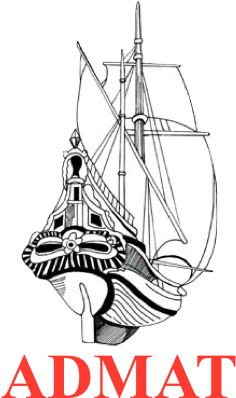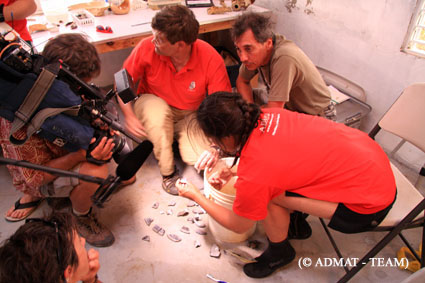Dr. Spooner on the Seabourn Legend for ADMAT's "Excavating Shipwrecks" lecture series.
President, Excavation Director & Co-founder
Dr. Simon Q. Spooner
Short Biography
Dr. Spooner is one of the world's leading experts in maritime archaeology and the protection of underwater cultural heritage. He is co-founder and President of the Anglo~Danish Maritime Archaeological Team (ADMAT), a non-profit organization working on the preservation of historic shipwrecks in the Caribbean. Dr. Spooner is also the President of ADMAT-FRANCE and President and co-creator of ADMAT USA, an American non-profit (Charity) organisation set up to assist in protecting historic shipwrecks and education. He has directed numerous excavations and surveys including, the White House Bay Wrecks (1780s), The Button Wreck (1740s) La Viette (1802), Faience Wreck (1760s), Le Casimir (1829), Le Dragon (1783), Tile Wreck (1720s), Musket Ball Wreck (1790s), The Island Wreck (1720's) and the survey for Santiago (1582) and the lost 1563 Spanish Fleet, Wreck One and the recently found Wreck Two.
Due to Dr. Spooner's extensive experience gained in the Dominican Republic for their Government, he advised the Government of St Kitts on how to protect their Underwater Cultural Heritage. He was the founder and director of the St Kitts Maritime Archaeological Project. In April 2003 he directed the White House Bay Wreck excavation in St Kitts, which is believed to be a 1740’s English Troopship sunk in 1782. This was Phase 1 of the St Kitts Maritime Archaeological Project.
In 2005 he received survey permits from NOAA, to conduct archaeological surveys of a number of historic wreck sites in the Florida Keys National Marine Sanctuary. ADMAT's Florida Maritime Archaeological Project began in July 2005, with a field school which started on The Button Wreck, a possible 1770's wreck, for NOAA & Florida Keys National Marine Sanctuary (FKNMS).
In late 2005 the Team started extensive maritime archaeological surveys in Monte Cristi on the north coast of the Dominican Republic on a number of historic shipwrecks. This work continues today from ADMAT's Maritime Archaeological Centre in Monte Cristi, with further maritime archaeological work on the Le Casimir, Faience Wreck, Tile Wreck, Le Dragon, The Island Wreck, Wreck One and Wreck Two and other historic wrecks sites. These historic sites include Christopher Columbus’s first settlement in the New World, La Isabela, where the Team found a Columbus-era anchor in the first 15 minutes of our geophysical survey.
Dr. Spooner's doctoral thesis was entitled “Maritime Taphonomy – A study of historic shipwreck formation process on the north coast of the Dominican Republic from 1563 to 1829”. He holds a BSc and is a Member of the Royal Institution of Chartered Surveyors, as well as being appointed to the Institute of Field Archaeologists at the Member level. He is a Fellow Honorary Member of the Société des Explorateurs Français and a Fellow International of The Explorers Club. He is also a member of the Ontario Marine Heritage Committee.
In 2009 he was appointed the Marine Heritage Advisor at the Ministry of Culture for the Government of Ontario in Canada. He provided expert technical advice to senior management, other government ministries, Cabinet, and stakeholders on underwater archaeology, cultural heritage, coastal zone management, shoreline development and cultural heritage landscapes and marine development policy initiatives. He was the protector of all underwater cultural heritage and shipwrecks, first nation artefacts, for a massive area, 158,000 sq miles of water, 250,000 lakes and over 100,000 km of rivers; and the entire Canadian side of the Great Lakes. This equates to an area the size of France and Italy combined. This area included the famous 1812 American warships the USS Hamilton and the USS Scourge which were gifted to the people of Canada in an unprecedented way and the modern Edmund Fitzgerald. Tragically in 2012, the government decided to abandon the protection of historic shipwrecks and underwater cultural heritage and his position was surpluses and closed, to the detriment of all in Northern America.
Dr. Spooner was the Senior Marine Archaeologist for Save Ontario Shipwrecks (SOS) in Ontario and assisted with their NAS training 2009-2012.
Between 2010-2022 ADMAT runs a maritime archaeological field school in Monte Cristi continuing its work in assisting the government in the protection of underwater cultural heritage.
Dr. Spooner is a well-known lecturer in Maritime Archaeology. He has taught university students from all over the world in a number of field schools on The Tile Wreck, Le Casimir, The Island Wreck, The White House Bay Wreck, The historic settlement of Isabela, Wreck One and Wreck Two and The Button Wreck. He has also lectured at Copenhagen University & Southampton. He was a Research Associate to MA maritime archaeological students at the University of Bristol. He has spoken at numerous conferences on the issue of the Protection of Underwater Cultural Heritage, from as far afield as Berlin to Cartagena. He spoke at The General Assembly of Nations, at the first UNESCO convention for the protection of underwater cultural heritage held in Paris in 2009, discussing the challenges of protecting UCH in the Caribbean. He has lectured from Vietnam to St. Lucia on Maritime Archaeology on the Seabourn, Crystal and Cunard Cruise Ships. He appeared in the "Caribbean Wreck Heaven" film with the White House Bay Wreck, ZIZ National TV in St. Kitts, El Informe TV program in the Dominican Republic and Thalassa 3 France National TV.
For the last three decades, he has been teaching divers and students. In 1991 he was appointed Advanced Instructor with the British Sub Aqua Club, as well as being a senior instructor with PADI and holding a 3 Star CMAS instructor ticket. Having dived all over the world he has now made over 10,000 dives, with thousands of hours spent underwater conducting archaeology. Dr. Spooner also is one of the very few archaeologists in the world who have a pilot’s license for the Oceaneering Hydra Magnum Commercial ROV. He is a protector of maritime archaeological sites in the Caribbean, fighting against looting, and treasure hunters as well as advising governments on how to protect their underwater cultural heritage.
Simon addressing the UNESCO conference at the UN in Paris.
Simon and the Team doing a piece to camera in 2010 for Thalassa 3 France National TV's film on ADMAT's work protecting French historic shipwrecks in the Dominican Republic.
Captain Patrick Enlow, Dr. Simon Q. Spooner, Isabella (Puppy) and Christine Nielsen, with a possible Columbus era kedge anchor recovered from La Isabela the first Columbus settlement of The New World on the north coast of the Dominican Republic, during the Indiana University-ADMAT field School in 2006. Dr Spooner and ADMAT located the anchor in the first 15 minutes of the survey while training students from Indiana University.





